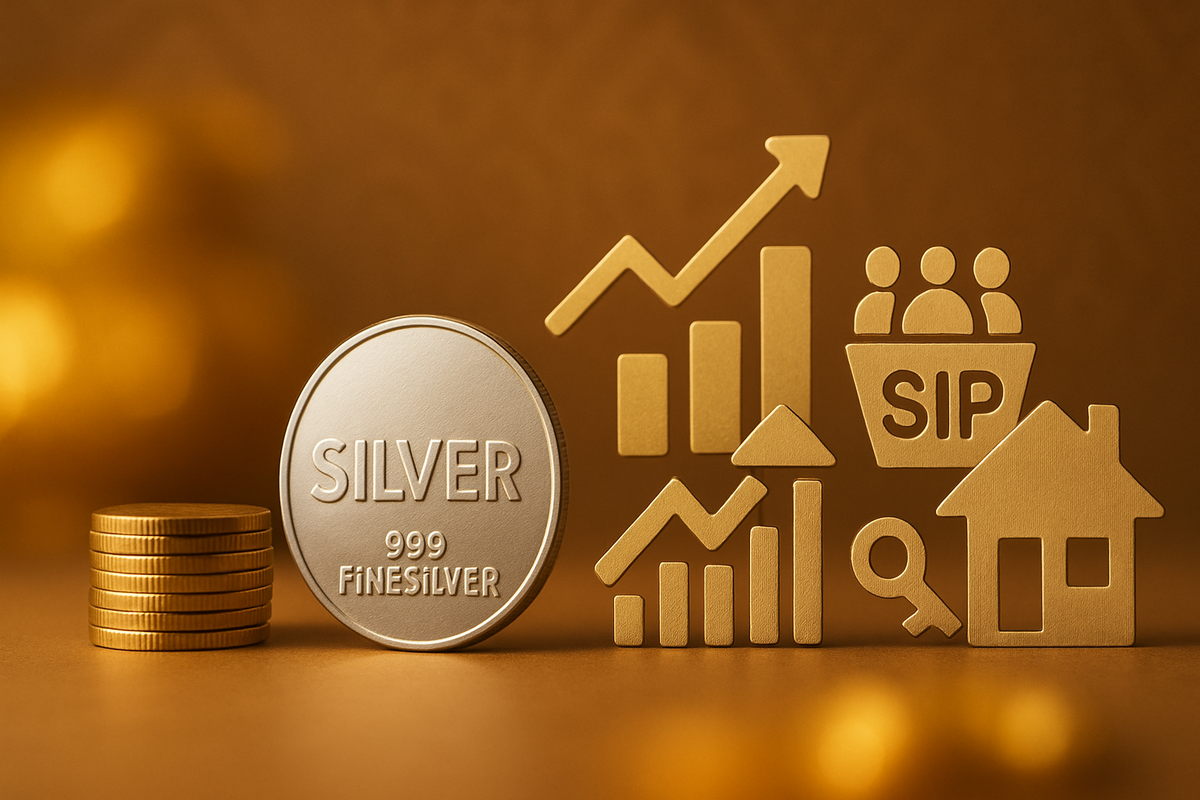
As Dhanteras 2025 approaches on October 18th, a day traditionally synonymous with purchasing gold to invite prosperity, Indian investors find themselves at a crossroads. With gold prices reaching unprecedented highs, both globally and domestically, the age-old tradition is undergoing a significant re-evaluation. While the cultural reverence for physical gold remains, the pragmatic realities of storage, purity concerns, and the sheer cost are pushing a growing segment of investors to explore more diversified and financially astute alternatives. This shift signals a maturing investment landscape where auspicious traditions are harmonized with modern financial wisdom, offering pathways to wealth creation that extend far beyond the traditional yellow metal.
The financial markets are currently witnessing a remarkable surge in gold prices. As of October 16, 2025, 24-karat gold in India is trading at an astounding ₹12,944 to ₹12,959 per gram, while globally, gold has breached the $4,000-an-ounce mark. This represents a staggering 55-60% increase for 24K gold from October 2024 to 2025, driven by a confluence of geopolitical uncertainties—including ongoing global conflicts and economic anxieties—coupled with robust demand for safe-haven assets. This environment has cultivated a strong market sentiment favoring diversification, with investors increasingly seeking financial instruments that offer security, liquidity, and potential for growth without the logistical burdens associated with physical gold. The focus has broadened to include modern gold investment avenues like digital gold and Sovereign Gold Bonds, alongside a wider array of financial products such as mutual funds, real estate, and even silver, all designed to honor the spirit of Dhanteras while building resilient portfolios.
Dhanteras 2025: A Modern Approach to Ancient Traditions
The steep ascent in gold prices has fundamentally altered the investment landscape for Dhanteras 2025, prompting a significant pivot from purely physical gold purchases to a more diverse portfolio of assets. Traditionally, Dhanteras, derived from 'Dhan' (wealth), is an auspicious occasion for acquiring precious metals, believed to usher in good fortune and financial stability. However, the current economic climate, characterized by record-high gold valuations, has spurred investors to look beyond conventional means. The average price of 24-karat gold in India has soared past ₹12,900 per gram, making substantial physical purchases less accessible for many and highlighting the need for alternatives. This shift is not merely a reaction to cost but also reflects a growing awareness of modern financial instruments that offer greater convenience, security, and potential for long-term growth.
The timeline leading up to this moment has seen gold consistently breaking new records, fueled by a complex interplay of global economic instability, persistent inflation fears, and sustained central bank demand. This upward trajectory has solidified gold's status as a safe-haven asset, yet its current valuation has made entry points challenging for new investors or those looking to expand their holdings. Key players in this evolving scenario include financial institutions promoting diversified products, digital gold platforms offering fractional ownership, and regulatory bodies overseeing the issuance of instruments like Sovereign Gold Bonds. Initial market reactions indicate a noticeable uptick in interest for these alternative investments, with a discernible shift in consumer behavior during festive seasons. This indicates a growing sophistication among investors, who are now balancing cultural traditions with sound financial planning, seeking to maximize returns and mitigate risks in a volatile market.
Beyond traditional gold, several attractive avenues are gaining traction for Dhanteras 2025. Digital Gold, offered by platforms like PhonePe and Google Pay, allows investors to buy and sell 24K gold online in fractional amounts, stored securely in insured vaults, eliminating concerns about purity, storage, and making charges. Sovereign Gold Bonds (SGBs), though new issuances were discontinued after the Union Budget 2025, remain a compelling option in the secondary market. Issued by the Reserve Bank of India (RBI), SGBs offer an annual interest rate of 2.5% over and above gold price appreciation, with tax-free capital gains upon maturity. Gold Exchange-Traded Funds (ETFs), such as those offered by Nippon India Mutual Fund (NSE: NIPPONIND) or ICICI Prudential Mutual Fund (NSE: ICICIPRULI), provide a liquid and cost-effective way to invest in gold, requiring a demat account. For those seeking broader market exposure, Gold Mutual Funds invest in Gold ETFs, simplifying the process for beginners.
Navigating the Market: Winners and Losers in a Diversified Dhanteras
The pivot towards alternative investments this Dhanteras will undoubtedly create distinct winners and losers within the financial ecosystem. Companies positioned to benefit significantly are those facilitating access to modern investment vehicles and diversified asset classes. Digital gold platforms and their underlying providers, such as MMTC-PAMP India Private Limited, are poised for substantial gains as investors increasingly opt for convenient, secure, and fractional gold ownership. Similarly, asset management companies offering Gold ETFs and Gold Mutual Funds, like HDFC Asset Management Company (NSE: HDFCAMC) and SBI Funds Management Private Limited, will likely see increased inflows as investors seek professionally managed and liquid gold exposure without the physical hassle.
Beyond gold-centric instruments, companies in the real estate sector, particularly those involved in Real Estate Investment Trusts (REITs), stand to gain. Developers like DLF Limited (NSE: DLF) might see a boost in sales, especially with festive season offers, as real estate continues to be a tangible, inflation-beating asset. REITs such as Embassy Office Parks REIT (NSE: EMBASSY) offer an accessible entry point into commercial real estate, appealing to investors looking for stable income and diversification. The silver market is also expected to flourish; companies involved in silver mining or silver ETFs, while less prominent in direct retail, could see increased investor interest. This includes broader commodity trading platforms and financial institutions facilitating access to silver futures or ETFs.
Conversely, traditional jewelry retailers focusing predominantly on physical gold ornaments might face challenges if they do not adapt to the changing investor preferences. While cultural demand for jewelry will persist, the investment-driven purchase of physical gold is likely to decline. Companies that fail to integrate digital gold options, offer buyback schemes, or innovate with lightweight, design-focused jewelry might experience a slowdown in sales during the festive season. The emphasis on 'investment' over 'ornamentation' for Dhanteras means that businesses heavily reliant on the latter, without offering a compelling value proposition in the former, could see their market share erode as financially savvy consumers prioritize wealth creation over traditional displays of wealth.
Wider Implications: A Shifting Paradigm in Indian Investments
The growing preference for diversified investments beyond physical gold on Dhanteras 2025 is not an isolated event but rather a significant indicator of broader, transformative trends within the Indian financial markets. This shift aligns perfectly with the global movement towards the digitization of finance and democratization of investment opportunities. As technology-aware investors, particularly the younger demographic, seek greater convenience, transparency, and liquidity, digital platforms offering gold, mutual funds, and stocks are becoming increasingly central to wealth management strategies. This trend also underscores the heightened importance of portfolio diversification as a risk mitigation strategy in an era of persistent global economic uncertainties and market volatility. Investors are no longer content to put all their 'Dhanteras eggs' in one golden basket, instead opting for a spread across asset classes to build resilience.
The ripple effects of this trend are far-reaching. Competitors and partners across the financial services industry are being compelled to innovate and expand their offerings. Traditional banks are enhancing their digital investment platforms, while fintech companies are introducing novel products that cater to this evolving investor mindset. This fosters a more competitive and dynamic market, ultimately benefiting the consumer with more choices and potentially better returns. From a regulatory and policy standpoint, this shift necessitates careful oversight to ensure investor protection in nascent markets like digital gold and to standardize disclosures across various investment products. The increased uptake of financial instruments also strengthens the formal financial sector, potentially leading to greater financial inclusion and a more robust capital market.
Historically, periods of high asset prices have often led to a search for alternatives. While not an exact parallel, the dot-com bubble of the late 1990s or the real estate boom prior to 2008 saw investors flocking to specific asset classes, only to diversify when prices became unsustainable or risks became apparent. The current scenario with gold mirrors this, with investors consciously seeking value and stability elsewhere. This Dhanteras marks a pivotal moment where cultural tradition meets financial pragmatism, setting a precedent for how future festive investments might evolve. It signifies a maturation of the Indian investor, moving from purely emotional or traditional choices to those informed by a deeper understanding of market dynamics and long-term financial goals.
The Road Ahead: Opportunities and Challenges for the Modern Investor
Looking ahead, the trend of diversifying investments beyond traditional physical gold for Dhanteras is set to solidify, presenting both significant opportunities and challenges for investors. In the short term, the sustained high gold prices are likely to keep alternatives like silver in the spotlight. Silver, often seen as the 'poor man's gold,' is not only auspicious for Dhanteras but also has significant industrial demand, potentially offering dual drivers for its price appreciation. Investors might increasingly explore silver ETFs or physical silver purchases. Similarly, the accessibility and efficiency of digital gold and Sovereign Gold Bonds (SGBs) will continue to attract those seeking gold exposure without the physical asset's drawbacks.
In the long term, the shift will reinforce the importance of a well-rounded financial portfolio. Mutual funds and Systematic Investment Plans (SIPs) across various asset classes—equity, debt, and hybrid—will become even more central to wealth creation strategies. This will necessitate greater financial literacy and advisory services to guide investors through the complexities of market-linked instruments. Real estate, particularly through the accessible route of REITs, is expected to maintain its allure as a tangible, inflation-beating asset, with developers potentially offering attractive schemes around festive periods. The emergence of new financial products tailored to festive investment themes is also a strong possibility, further blurring the lines between traditional practices and modern finance.
Potential strategic pivots for financial institutions will involve enhancing their digital platforms, expanding their product offerings to cater to diversified demands, and focusing on investor education. Market opportunities will emerge in specialized fintech solutions for precious metals, personalized wealth management services, and innovative real estate investment models. Challenges will include navigating regulatory complexities for new products, ensuring robust cybersecurity for digital platforms, and managing investor expectations in volatile markets. Ultimately, the coming months will likely see a continued evolution in how Indians celebrate Dhanteras, transforming it from a mere shopping spree into a strategic annual review of their financial health and investment portfolio, with an increasing emphasis on smart, diversified wealth accumulation.
A New Golden Era: Diversification as the Key to Prosperity
Dhanteras 2025 stands as a pivotal moment, signaling a profound shift in Indian investment culture. The era of unquestioning reliance on physical gold for auspicious purchases is giving way to a more sophisticated, diversified approach, driven by record-high gold prices and a growing understanding of modern financial instruments. The key takeaway is clear: while the sentiment of Dhanteras remains rooted in inviting prosperity, the methods for achieving it are evolving. Investors are now empowered with a broader spectrum of choices, from the digital convenience of online gold to the strategic growth offered by mutual funds, real estate, and the steady appeal of silver.
Moving forward, the market will likely continue to reward prudence and diversification. The sustained interest in alternative precious metals like silver, alongside robust financial instruments, underscores a healthy maturation of the Indian investment landscape. This shift isn't just about avoiding high gold prices; it's about embracing financial resilience, maximizing returns, and aligning investment strategies with long-term wealth creation goals. Investors should closely monitor global economic indicators, commodity price trends, and regulatory developments in the fintech space. The lasting impact of this Dhanteras will be a more informed and empowered investor base, ready to navigate the complexities of modern finance while honoring cherished traditions. The true 'golden era' of investment may well be one defined not by a single metal, but by a strategically diversified portfolio.
This content is intended for informational purposes only and is not financial advice





